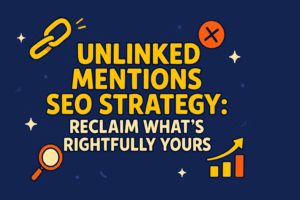
A lot of website owners and bloggers use nofollow links as a way to control their link-building and improve their SEO. Most of them don’t even realize that these links have the potential to help or harm their search engine rankings. And most of them don’t even know what nofollow links are.
In this blog post, we will explore nofollow links, the difference between nofollow and dofollow links, how to check if a link is nofollow or dofollow, and the different types of it. We’ll also discuss whether or not these links are good for SEO and answer some common questions about them.
So, let’s start by defining them,
What Is Nofollow Link?

A nofollow link is a hyperlink that tells search engines not to follow or crawl this particular link. It also ensures that the links you are giving don’t share your domain authority. They are often used to prevent spammy backlinks, promote good content, and maintain control over the links on your website.
This is just the tip of the iceberg regarding nofollow links. If you want to learn more, keep on reading!
Difference Between Nofollow And Dofollow Links
There is a lot of confusion surrounding the difference between nofollow and dofollow links. At their core, these are simply different types of hyperlinks that serve different purposes.
A nofollow link tells search engines not to crawl it, while a dofollow link allows them to do so.
In general, They are used for sponsored posts and paid advertisements. They are also helpful in controlling your website’s outgoing links or preventing spammy backlinks.
On the other hand, dofollow links are typically used to promote content and share valuable information with the online community. And, It also shares the domain authority with that link.
How To Check If A Link Is Nofollow Or Dofollow
Here are two ways to quickly check if a link is nofollow or dofollow.
- The first option, which involves using a browser extension, is quick and easy. A browser extension named “Strike Out Nofollow Links” is designed to highlight these links on a webpage. Install the extension, and you can identify these links on any website.
Alternatively, you can use a tool like Moz’s Open Site Explorer or Majestic to analyze links on your website and see if they are nofollow or dofollow. Enter the URL of your website and select “Difficulty” from the dropdown menu. This will show you a list of all the external links pointing to your website, with nofollow links highlighted in red.
- The second option requires using your browser’s ‘View Source’ function. To do this, right-click the link you want to check and select “View Page Source.” Look for the ‘rel’ attribute of the link, which will tell you whether it is nofollow or dofollow.
Here’s a link example that is nofollow:
<a href=”https://example.com” rel=”nofollow”>Example Link</a>
And here’s a link example that is dofollow:
<a href=”https://example.com”>Example Link</a>
Types Of Nofollow Links
Well, there are several different types of nofollow links; some of them are as follows:
- Sponsored links, such as those found in paid advertisements or sponsored blog posts.
- Links that are embedded in comments on blogs and other online forums.
- Links within widgets and badges on your website or social media profiles.
- Links within user profiles and user comments on social media platforms.
- Links within rich snippets, such as those in Google Rich Snippets or Schema.org markup.
- Links within sidebars and footers of websites or apps.
Why Did Search Engine Create Nofollow Tag?
Due to the expansion of blog spam, Google created the nofollow tag as a measure of protection. Spammers had begun posting comments with links to their sites, so the nofollow tag was developed and implemented to discourage this unwanted behavior.
This caused two major problems:
- First, spammy sites started to rank well in Google. This pushed high-quality sites out of the search results.
- Blog comment spamming became rampant and overwhelming due to its effectiveness. As a result, Google developed the nofollow tag in 2005 and incorporated it into their algorithm, ultimately followed by other search engine giants such as Bing and Yahoo.
Do Nofollow Links Good For SEO?
This question has no definitive answer, as these links can positively and negatively affect your website’s SEO. They can help you build valuable backlinks and promote your content but they can also be a sign of low-quality or spammy backlinks.
Ultimately, the effectiveness of these links will depend on several factors, such as the quality of both your website and the linking websites and the type and placement of nofollow links on your website.
That said, there is some evidence that nofollow links can have a small impact on your website’s SEO.
For example, research has shown that these links can improve click-through rates and rankings for particular keywords. Additionally, some studies have found that they can boost domain authority and increase organic traffic.
As with all aspects of SEO, it’s essential to constantly monitor and analyze your website’s performance, using tools like Google Search Console to track rankings and metrics. With this data, you can make informed decisions about the value and effectiveness of nofollow links for your website.
Google’s Comment On Nofollow Links
Google is one of the biggest proponents of nofollow links, as they help prevent spammy backlinks and keep online content high-quality and relevant. They say these links can benefit publishers and web admins for specific reasons.
Google also discourages web admins from buying links, which can damage their website’s trust and reputation. Rather than trying to manipulate rankings with paid links, Google recommends creating high-quality, valuable content that naturally attracts backlinks.
Overall, nofollow links are essential to any successful content marketing strategy. You can improve your website’s SEO and reach a wider audience by building healthy, engaged communities online and creating valuable content that people want to read, share, and link to.
FAQs
Q- Do Nofollow Links Get Indexed?
No, these links cannot be indexed by search engines like Google. However, there is no guarantee that they will be crawled and added to the search index. This will depend on several factors, including the quality and authority of the linking website.
Q- Do Nofollow Links Pass PageRank?
No, they do not pass PageRank or any other link metrics from the linking website to your website. But they can still be valuable for SEO and building backlinks.
Q- Can Nofollow Links Hurt SEO?
They can hurt your SEO, especially from low-quality or spammy websites. However, many factors can also impact your website’s SEO, such as the quality and quantity of backlinks, on-page optimization factors, and much more. As such, there is no definitive answer to this question.
Final Thoughts
Now that you understand what nofollow links are and how they can affect your SEO, it’s essential to carefully consider the value of these links when building your website’s backlink profile.
However, links should not be the only focus of your SEO efforts. Instead, focus on creating valuable content and building relationships with other websites to attract more dofollow links. This is the key to achieving long-term SEO success.
If you have nofollow links, please leave your questions in the comment section. We will be happy to answer you.
Thanks for reading 🙂


